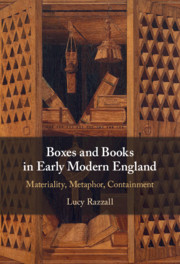Book contents
- Boxes and Books in Early Modern England
- Boxes and Books in Early Modern England
- Copyright page
- Contents
- Figures
- Acknowledgments
- A Note on Texts
- Introduction
- Chapter 1 Chests of the Mind in Early Modern England
- Chapter 2 The Renaissance of the Box
- Chapter 3 The Word in a Box
- Chapter 4 How to Read a Reliquary
- Chapter 5 ‘Because this box we know’
- Conclusion
- Bibliography
- Primary Sources
- Secondary Sources
- Index
- Boxes and Books in Early Modern England
- Boxes and Books in Early Modern England
- Copyright page
- Contents
- Figures
- Acknowledgments
- A Note on Texts
- Introduction
- Chapter 1 Chests of the Mind in Early Modern England
- Chapter 2 The Renaissance of the Box
- Chapter 3 The Word in a Box
- Chapter 4 How to Read a Reliquary
- Chapter 5 ‘Because this box we know’
- Conclusion
- Bibliography
- Primary Sources
- Secondary Sources
- Index
Summary
In the remarkable story of the chance discovery of the Elizabethan astrologer John Dee’s papers in 1672, a humble household chest belonging to a married couple plays a starring role. The seventeenth-century antiquary Elias Ashmole recounts how one day the chest was moved, and in a secret hidden drawer the chest’s owners came across Dee’s papers alongside a little box, some books, and prayer beads. In Ashmole’s account, this chest, a seemingly ordinary piece of household furniture, turns out to be a miraculous repository of other boxes, whose contents open onto England’s Elizabethan and Catholic pasts. The Introduction considers this extraordinary episode in the light of an essay by Primo Levi, who proposes that ‘building receptacles’ is a distinctively human activity. In the literary and material cultures of early modern England, the box is one of the most ordinary and necessary of human-made objects. As Boxes and Books in Early Modern England will explore, the box is also an evocative meeting point between matter and metaphor, influencing the material and mental environments of early modern writing in numerous ways.
- Type
- Chapter
- Information
- Boxes and Books in Early Modern EnglandMateriality, Metaphor, Containment, pp. 1 - 29Publisher: Cambridge University PressPrint publication year: 2021

